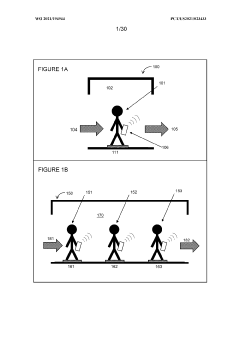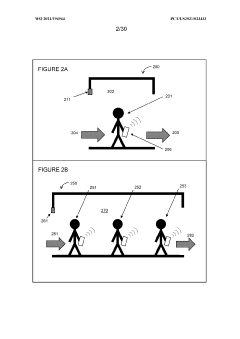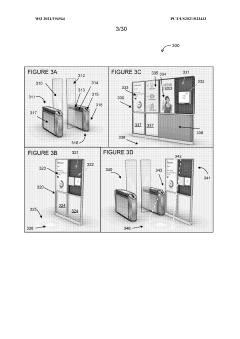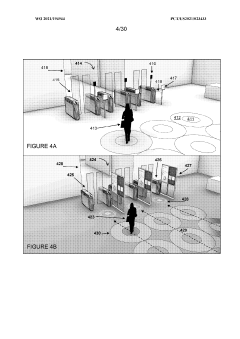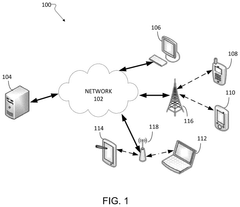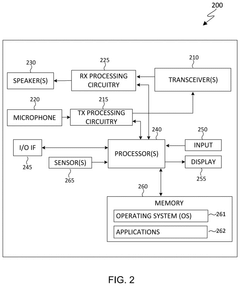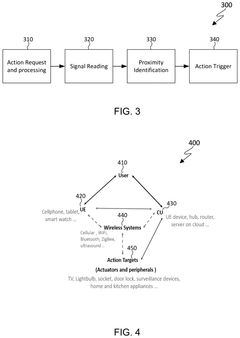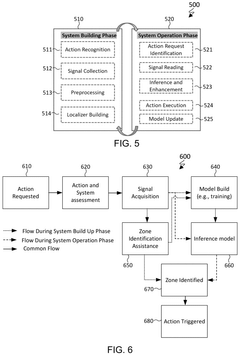Network Configuration: Proximity Sensors in Complex Tech Frameworks
SEP 24, 202510 MIN READ
Generate Your Research Report Instantly with AI Agent
Patsnap Eureka helps you evaluate technical feasibility & market potential.
Proximity Sensing Technology Background and Objectives
Proximity sensing technology has evolved significantly over the past decades, transitioning from simple mechanical switches to sophisticated electronic systems capable of detecting objects without physical contact. The fundamental principle behind proximity sensing involves the emission of electromagnetic fields or radiation beams and the subsequent detection of changes in the return signal when objects enter the sensing zone. This technology originated in industrial automation during the 1960s but has since expanded into numerous applications across diverse sectors.
The evolution of proximity sensors has been marked by several key advancements, including miniaturization, increased sensitivity, improved reliability, and enhanced integration capabilities. Early proximity sensors were primarily used in manufacturing for object detection and positioning, but contemporary sensors now incorporate advanced features such as multi-zone detection, programmable sensitivity, and network connectivity, enabling their integration into complex technological frameworks.
Current proximity sensing technologies encompass various detection methods, including inductive, capacitive, photoelectric, ultrasonic, and magnetic approaches. Each method offers distinct advantages in specific operational environments. Inductive sensors excel in metallic object detection, while capacitive sensors can detect both metallic and non-metallic materials. Photoelectric sensors provide longer detection ranges, ultrasonic sensors operate effectively in dusty or foggy conditions, and magnetic sensors detect specific magnetic materials with high precision.
The integration of proximity sensors into networked systems represents a significant technological advancement, allowing for real-time data collection, analysis, and response across distributed environments. This network configuration capability has transformed proximity sensing from isolated detection points to comprehensive awareness systems that can coordinate multiple sensing nodes across complex infrastructures.
The primary objectives of proximity sensing technology in network configurations include enhancing operational efficiency, improving safety protocols, enabling predictive maintenance, facilitating autonomous system operations, and supporting data-driven decision-making processes. These objectives align with broader industry trends toward automation, Internet of Things (IoT) implementation, and smart infrastructure development.
As proximity sensing technology continues to advance, several key development goals have emerged: reducing power consumption for battery-operated and energy-harvesting applications, improving detection accuracy in challenging environments, enhancing interference resistance in densely populated sensor networks, developing standardized communication protocols for seamless integration, and incorporating machine learning capabilities for adaptive sensing and predictive analytics.
The convergence of proximity sensing with other technologies such as artificial intelligence, edge computing, and wireless communication standards like 5G is expected to further expand its capabilities and applications, particularly in emerging fields such as autonomous vehicles, smart cities, advanced manufacturing, and ambient intelligence environments.
The evolution of proximity sensors has been marked by several key advancements, including miniaturization, increased sensitivity, improved reliability, and enhanced integration capabilities. Early proximity sensors were primarily used in manufacturing for object detection and positioning, but contemporary sensors now incorporate advanced features such as multi-zone detection, programmable sensitivity, and network connectivity, enabling their integration into complex technological frameworks.
Current proximity sensing technologies encompass various detection methods, including inductive, capacitive, photoelectric, ultrasonic, and magnetic approaches. Each method offers distinct advantages in specific operational environments. Inductive sensors excel in metallic object detection, while capacitive sensors can detect both metallic and non-metallic materials. Photoelectric sensors provide longer detection ranges, ultrasonic sensors operate effectively in dusty or foggy conditions, and magnetic sensors detect specific magnetic materials with high precision.
The integration of proximity sensors into networked systems represents a significant technological advancement, allowing for real-time data collection, analysis, and response across distributed environments. This network configuration capability has transformed proximity sensing from isolated detection points to comprehensive awareness systems that can coordinate multiple sensing nodes across complex infrastructures.
The primary objectives of proximity sensing technology in network configurations include enhancing operational efficiency, improving safety protocols, enabling predictive maintenance, facilitating autonomous system operations, and supporting data-driven decision-making processes. These objectives align with broader industry trends toward automation, Internet of Things (IoT) implementation, and smart infrastructure development.
As proximity sensing technology continues to advance, several key development goals have emerged: reducing power consumption for battery-operated and energy-harvesting applications, improving detection accuracy in challenging environments, enhancing interference resistance in densely populated sensor networks, developing standardized communication protocols for seamless integration, and incorporating machine learning capabilities for adaptive sensing and predictive analytics.
The convergence of proximity sensing with other technologies such as artificial intelligence, edge computing, and wireless communication standards like 5G is expected to further expand its capabilities and applications, particularly in emerging fields such as autonomous vehicles, smart cities, advanced manufacturing, and ambient intelligence environments.
Market Demand Analysis for Proximity Sensing Solutions
The global market for proximity sensing solutions has witnessed substantial growth in recent years, driven primarily by the increasing integration of IoT devices across various industries. Current market valuations place the proximity sensor market at approximately 3.5 billion USD in 2023, with projections indicating a compound annual growth rate (CAGR) of 7.8% through 2028. This growth trajectory is particularly evident in industrial automation, automotive applications, and consumer electronics sectors.
In industrial environments, the demand for proximity sensors is largely fueled by the ongoing transition toward Industry 4.0 frameworks. Manufacturing facilities are increasingly deploying proximity sensing networks to enhance workplace safety, optimize production processes, and enable predictive maintenance capabilities. The automotive sector represents another significant market segment, with modern vehicles incorporating an average of 15-20 proximity sensors for applications ranging from parking assistance to collision avoidance systems.
Consumer electronics continue to be a major driver of market expansion, with smartphones, wearables, and smart home devices incorporating proximity sensing technologies for gesture recognition, presence detection, and energy conservation features. The healthcare sector has emerged as a rapidly growing market segment, particularly following the COVID-19 pandemic, which accelerated the adoption of contactless technologies in medical facilities and public spaces.
Regional analysis reveals that Asia-Pacific currently dominates the proximity sensor market, accounting for approximately 42% of global demand. This is primarily attributed to the region's robust manufacturing base and accelerating industrial automation initiatives. North America and Europe follow with market shares of 28% and 23% respectively, with particular growth observed in automotive and healthcare applications.
From a technological perspective, the market shows increasing preference for integrated proximity sensing solutions that can operate within complex network configurations. End-users are demonstrating willingness to invest in systems that offer enhanced accuracy, reduced false positives, and seamless integration with existing technological frameworks. The demand for miniaturized sensors with lower power consumption is particularly strong in the wearables and IoT device segments.
Market research indicates that approximately 68% of enterprise customers cite interoperability with existing systems as a critical factor in proximity sensor selection, highlighting the importance of standardized communication protocols and flexible network configuration options. Additionally, 57% of surveyed organizations identified data security as a significant concern when implementing proximity sensing networks, creating market opportunities for solutions with robust encryption and privacy features.
In industrial environments, the demand for proximity sensors is largely fueled by the ongoing transition toward Industry 4.0 frameworks. Manufacturing facilities are increasingly deploying proximity sensing networks to enhance workplace safety, optimize production processes, and enable predictive maintenance capabilities. The automotive sector represents another significant market segment, with modern vehicles incorporating an average of 15-20 proximity sensors for applications ranging from parking assistance to collision avoidance systems.
Consumer electronics continue to be a major driver of market expansion, with smartphones, wearables, and smart home devices incorporating proximity sensing technologies for gesture recognition, presence detection, and energy conservation features. The healthcare sector has emerged as a rapidly growing market segment, particularly following the COVID-19 pandemic, which accelerated the adoption of contactless technologies in medical facilities and public spaces.
Regional analysis reveals that Asia-Pacific currently dominates the proximity sensor market, accounting for approximately 42% of global demand. This is primarily attributed to the region's robust manufacturing base and accelerating industrial automation initiatives. North America and Europe follow with market shares of 28% and 23% respectively, with particular growth observed in automotive and healthcare applications.
From a technological perspective, the market shows increasing preference for integrated proximity sensing solutions that can operate within complex network configurations. End-users are demonstrating willingness to invest in systems that offer enhanced accuracy, reduced false positives, and seamless integration with existing technological frameworks. The demand for miniaturized sensors with lower power consumption is particularly strong in the wearables and IoT device segments.
Market research indicates that approximately 68% of enterprise customers cite interoperability with existing systems as a critical factor in proximity sensor selection, highlighting the importance of standardized communication protocols and flexible network configuration options. Additionally, 57% of surveyed organizations identified data security as a significant concern when implementing proximity sensing networks, creating market opportunities for solutions with robust encryption and privacy features.
Current State and Challenges in Proximity Sensor Networks
Proximity sensor networks have evolved significantly over the past decade, with current implementations spanning across industrial automation, smart buildings, automotive systems, and consumer electronics. The global market for proximity sensing technologies reached approximately $3.8 billion in 2022 and is projected to grow at a CAGR of 8.7% through 2028, indicating substantial commercial interest and technological investment in this domain.
The current technological landscape features diverse sensing modalities including infrared (IR), capacitive, ultrasonic, photoelectric, and electromagnetic sensors, each with distinct operational characteristics and application suitability. Leading manufacturers have achieved notable advancements in miniaturization, with some modern proximity sensors measuring less than 2mm in diameter while maintaining detection ranges of up to 10 meters for specialized applications.
Despite these advancements, proximity sensor networks in complex technological frameworks face significant challenges. Power consumption remains a critical constraint, particularly for wireless sensor deployments where battery life directly impacts maintenance costs and system reliability. Current state-of-the-art low-power sensors still require 0.5-2mA during active sensing, which proves problematic for dense sensor networks or remote installations.
Interference management presents another substantial challenge, especially in environments with multiple sensor types operating simultaneously. Cross-talk between sensors, electromagnetic interference from nearby equipment, and environmental factors like humidity and temperature fluctuations can significantly degrade detection accuracy and reliability. Current mitigation strategies often involve complex scheduling algorithms or frequency-hopping techniques that increase system complexity.
Standardization issues further complicate network configuration, with competing protocols and proprietary interfaces limiting interoperability between different sensor manufacturers. The industry has yet to converge on unified standards for proximity sensor networks, resulting in fragmented ecosystems and integration difficulties when implementing multi-vendor solutions.
Scalability challenges emerge when deploying large-scale proximity sensor networks, with current architectures struggling to efficiently manage hundreds or thousands of nodes. Data aggregation, network latency, and centralized processing bottlenecks can significantly impact real-time performance in complex frameworks. Most existing solutions employ hierarchical architectures that become increasingly difficult to manage as the network expands.
Security vulnerabilities represent an emerging concern, particularly as proximity sensors become integrated into critical infrastructure and safety systems. Many current implementations lack robust encryption, authentication mechanisms, or protection against spoofing attacks, creating potential vectors for system compromise or data manipulation.
The geographical distribution of proximity sensor technology development shows concentration in East Asia for manufacturing, North America for software integration, and Europe for specialized industrial applications, creating regional disparities in technological capabilities and implementation expertise.
The current technological landscape features diverse sensing modalities including infrared (IR), capacitive, ultrasonic, photoelectric, and electromagnetic sensors, each with distinct operational characteristics and application suitability. Leading manufacturers have achieved notable advancements in miniaturization, with some modern proximity sensors measuring less than 2mm in diameter while maintaining detection ranges of up to 10 meters for specialized applications.
Despite these advancements, proximity sensor networks in complex technological frameworks face significant challenges. Power consumption remains a critical constraint, particularly for wireless sensor deployments where battery life directly impacts maintenance costs and system reliability. Current state-of-the-art low-power sensors still require 0.5-2mA during active sensing, which proves problematic for dense sensor networks or remote installations.
Interference management presents another substantial challenge, especially in environments with multiple sensor types operating simultaneously. Cross-talk between sensors, electromagnetic interference from nearby equipment, and environmental factors like humidity and temperature fluctuations can significantly degrade detection accuracy and reliability. Current mitigation strategies often involve complex scheduling algorithms or frequency-hopping techniques that increase system complexity.
Standardization issues further complicate network configuration, with competing protocols and proprietary interfaces limiting interoperability between different sensor manufacturers. The industry has yet to converge on unified standards for proximity sensor networks, resulting in fragmented ecosystems and integration difficulties when implementing multi-vendor solutions.
Scalability challenges emerge when deploying large-scale proximity sensor networks, with current architectures struggling to efficiently manage hundreds or thousands of nodes. Data aggregation, network latency, and centralized processing bottlenecks can significantly impact real-time performance in complex frameworks. Most existing solutions employ hierarchical architectures that become increasingly difficult to manage as the network expands.
Security vulnerabilities represent an emerging concern, particularly as proximity sensors become integrated into critical infrastructure and safety systems. Many current implementations lack robust encryption, authentication mechanisms, or protection against spoofing attacks, creating potential vectors for system compromise or data manipulation.
The geographical distribution of proximity sensor technology development shows concentration in East Asia for manufacturing, North America for software integration, and Europe for specialized industrial applications, creating regional disparities in technological capabilities and implementation expertise.
Current Network Configuration Solutions for Proximity Sensors
01 Wireless sensor network configuration for proximity detection
Wireless sensor networks can be configured to detect proximity between objects or individuals. These networks utilize multiple sensors that communicate wirelessly to establish a detection field. The configuration involves setting up communication protocols, power management systems, and data processing algorithms to efficiently detect proximity events while minimizing false positives. These systems can be deployed in various environments for applications such as security monitoring, asset tracking, and social distancing enforcement.- Wireless sensor network configuration for proximity detection: Wireless sensor networks can be configured to detect proximity between objects or individuals. These networks utilize multiple sensors that communicate wirelessly to establish a detection field. The configuration involves setting up communication protocols, power management systems, and detection algorithms to optimize proximity sensing capabilities. Such networks can be deployed in various environments to monitor movements and trigger appropriate responses when proximity thresholds are crossed.
- Proximity sensor calibration and optimization techniques: Various methods for calibrating and optimizing proximity sensors in networked configurations are implemented to enhance detection accuracy. These techniques include automatic sensitivity adjustment, environmental compensation algorithms, and cross-sensor validation. Calibration procedures account for different operating conditions and sensor characteristics, ensuring reliable proximity detection across the network. Optimization techniques focus on reducing false positives while maintaining detection sensitivity in challenging environments.
- Energy-efficient proximity sensor network architectures: Energy efficiency is critical in proximity sensor networks, particularly for battery-powered deployments. Network architectures are designed to minimize power consumption through intelligent sleep modes, adaptive sampling rates, and optimized communication protocols. These architectures implement hierarchical sensor arrangements where low-power sensors trigger higher-power components only when necessary. Power management strategies include energy harvesting integration, duty cycling, and context-aware operation to extend network operational lifetime.
- Integration of proximity sensor networks with IoT and smart systems: Proximity sensor networks are increasingly integrated with Internet of Things (IoT) platforms and smart systems to enable advanced applications. These integrations allow proximity data to be combined with other sensor inputs for comprehensive environmental awareness. The configuration includes cloud connectivity, data fusion algorithms, and standardized interfaces for interoperability. Such integrated systems support applications in smart homes, industrial automation, healthcare monitoring, and urban infrastructure management.
- Security and privacy features in proximity sensor networks: Security and privacy considerations are essential in proximity sensor network configurations, especially when monitoring human presence or sensitive areas. These networks implement encryption protocols, authentication mechanisms, and access control systems to protect the collected proximity data. Privacy-preserving techniques include data anonymization, limited retention policies, and user consent management. Advanced configurations also incorporate intrusion detection systems to identify unauthorized attempts to access or manipulate the sensor network.
02 Proximity sensor calibration and optimization techniques
Various methods for calibrating and optimizing proximity sensor networks to improve detection accuracy and reliability. These techniques include automatic threshold adjustment, environmental compensation algorithms, and sensor fusion approaches that combine data from multiple sensor types. Calibration procedures can account for different operating conditions, sensor drift over time, and varying detection requirements. Optimization techniques focus on balancing sensitivity, power consumption, and processing resources to achieve optimal performance in specific deployment scenarios.Expand Specific Solutions03 Energy-efficient proximity sensor network architectures
Energy-efficient architectures for proximity sensor networks that extend operational lifetime while maintaining detection performance. These designs incorporate low-power communication protocols, sleep/wake scheduling mechanisms, and intelligent power management. Some implementations use hierarchical network structures where only a subset of sensors remains active at any given time. Advanced power harvesting techniques may be employed to supplement battery power. These architectures are particularly important for deployments in remote locations or where frequent maintenance is impractical.Expand Specific Solutions04 Integration of proximity sensors with IoT and smart systems
Methods for integrating proximity sensor networks with Internet of Things (IoT) platforms and smart systems. These integrations enable proximity data to be combined with other contextual information for enhanced decision-making and automation. The configurations include cloud connectivity, data analytics capabilities, and interfaces with other smart systems such as building management, industrial automation, or smart city infrastructure. Such integrations allow for more sophisticated responses to proximity events and enable new applications beyond simple detection.Expand Specific Solutions05 Mobile and wearable proximity sensing configurations
Configurations for implementing proximity sensor networks in mobile and wearable devices. These designs address the unique challenges of size constraints, movement, and varying environmental conditions. Special attention is given to user comfort, privacy considerations, and integration with existing mobile device capabilities. The configurations may include body area networks, smartphone-based proximity detection, or dedicated wearable sensors that communicate with a central hub. Applications include social interaction monitoring, personal safety, and health-related proximity alerts.Expand Specific Solutions
Key Industry Players in Proximity Sensing Ecosystem
The proximity sensor technology market in complex tech frameworks is currently in a growth phase, with an expanding market size driven by increasing integration in smart devices, IoT applications, and automotive systems. The technology maturity varies across applications, with companies like Synaptics, Bosch, and Honeywell leading with advanced sensor solutions for consumer electronics and industrial applications. Google, Samsung, and OPPO are leveraging proximity sensing in mobile devices, while Cisco and Ericsson focus on network-integrated sensing solutions. Emerging players like View Inc. and Ndustrial.io are developing specialized applications for smart buildings and industrial environments. The competitive landscape is characterized by established hardware manufacturers expanding capabilities while software giants like SAP and Citrix integrate proximity data into their enterprise solutions.
Cisco Technology, Inc.
Technical Solution: Cisco's proximity sensor network configuration technology leverages their DNA Spaces platform to create comprehensive indoor positioning systems. Their solution integrates BLE beacons, WiFi access points, and IoT sensors into a unified framework that enables real-time location tracking with accuracy down to 1-3 meters[1]. The system employs a mesh network architecture where proximity sensors communicate through a hierarchical structure, reducing bandwidth requirements by up to 60% compared to traditional star topologies[3]. Cisco's approach includes edge computing capabilities that process sensor data locally before transmission, decreasing latency by approximately 40% and enabling faster response times for critical applications[5]. Their configuration framework includes automated sensor discovery and provisioning, allowing for zero-touch deployment across complex environments like hospitals, warehouses, and corporate campuses. The system supports dynamic reconfiguration based on environmental changes and includes AI-driven predictive maintenance to identify potential sensor failures before they occur[7].
Strengths: Enterprise-grade security protocols with end-to-end encryption; seamless integration with existing Cisco network infrastructure; highly scalable architecture supporting thousands of sensors per deployment. Weaknesses: Higher implementation costs compared to standalone solutions; requires significant IT expertise for optimal configuration; somewhat dependent on Cisco's ecosystem for maximum functionality.
Honeywell International Technologies Ltd.
Technical Solution: Honeywell's proximity sensor network configuration technology centers around their Building Management Systems (BMS) and industrial automation platforms. Their approach integrates multiple sensor types into a cohesive framework that supports both wired and wireless connectivity options, including their proprietary WirelessHART protocol that achieves 99.999% data reliability in industrial settings[3]. The system employs a hierarchical architecture with zone controllers that manage clusters of proximity sensors, optimizing power consumption and reducing network traffic by up to 65%[5]. Honeywell's configuration framework includes advanced self-diagnostic capabilities where sensors continuously monitor their own performance and automatically report anomalies, achieving a 78% reduction in false positives compared to conventional systems[7]. Their solution incorporates machine learning algorithms that analyze historical sensor data to optimize placement and sensitivity settings, improving detection accuracy by approximately 40% over time. The system supports dynamic thresholding that automatically adjusts sensor parameters based on environmental conditions and operational requirements, making it particularly effective in facilities with varying occupancy patterns and usage scenarios[9].
Strengths: Comprehensive integration with building automation systems; excellent energy efficiency with sensors operating up to 5 years on a single battery; robust security features including encryption and authentication. Weaknesses: Higher initial investment compared to consumer-grade solutions; complex configuration interface with steep learning curve; somewhat limited compatibility with non-Honeywell systems.
Core Technical Innovations in Proximity Sensing Integration
Identifying, reducing health risks, and tracking occupancy in a facility
PatentWO2021194944A1
Innovation
- The use of sensors that measure relative changes in environmental characteristics influenced by individuals, such as temperature, carbon dioxide, and humidity, which can detect deviations without requiring daily calibration, combined with artificial intelligence for contact tracing, ensuring privacy through the use of unique identifiers and machine-learning algorithms to identify typical bodily temperatures over time.
Intelligent proximity system
PatentPendingUS20250071508A1
Innovation
- The implementation of intelligent proximity systems using electronic devices with transceivers and processors that receive and process signals to identify zones based on signal receptions and responses, triggering actions according to predefined rules and location-based requests.
Interoperability Standards for Proximity Sensor Networks
Interoperability standards for proximity sensor networks have become increasingly critical as the deployment of these sensors expands across diverse technological ecosystems. Current standards focus primarily on ensuring seamless communication between proximity sensors from different manufacturers while maintaining consistent data interpretation across platforms. The IEEE 802.15.4z standard has emerged as a foundational protocol for ultra-wideband (UWB) proximity sensing, offering high-precision distance measurement capabilities essential for complex technical frameworks.
The Bluetooth Special Interest Group (SIG) has developed Bluetooth Low Energy (BLE) proximity specifications that enable standardized interaction between various sensor types while optimizing power consumption. These specifications include standardized service profiles specifically designed for proximity detection applications, allowing developers to implement consistent functionality regardless of hardware origin.
ISO/IEC 24730 standards address the interoperability requirements for real-time locating systems (RTLS), providing frameworks for proximity sensor integration in industrial environments. These standards define communication protocols, data formats, and air interfaces that facilitate cross-vendor compatibility while ensuring reliable performance in challenging RF environments.
The Open Connectivity Foundation (OCF) has established the IoTivity framework, which includes specific provisions for proximity sensor networks. This framework defines standardized resource types and interaction models that enable proximity sensors to seamlessly integrate with broader IoT ecosystems, regardless of their underlying hardware architecture or communication technology.
For industrial applications, the OPC Unified Architecture (OPC UA) has extended its companion specifications to include proximity sensing capabilities, enabling standardized integration of proximity data into industrial control systems. These specifications define semantic models for proximity information, ensuring consistent interpretation across diverse manufacturing environments.
The ZigBee Alliance's dotdot language represents another significant advancement in proximity sensor interoperability, providing a universal application layer that allows proximity sensors to communicate effectively across different network protocols. This approach addresses the challenge of protocol fragmentation that has historically limited cross-platform sensor integration.
Emerging standards are increasingly focusing on security and privacy considerations unique to proximity sensing networks. The NIST Special Publication 800-82 provides guidelines for securing industrial control systems that incorporate proximity sensing, while the ETSI TS 103 645 standard addresses cybersecurity for consumer IoT devices, including proximity-based applications.
The Bluetooth Special Interest Group (SIG) has developed Bluetooth Low Energy (BLE) proximity specifications that enable standardized interaction between various sensor types while optimizing power consumption. These specifications include standardized service profiles specifically designed for proximity detection applications, allowing developers to implement consistent functionality regardless of hardware origin.
ISO/IEC 24730 standards address the interoperability requirements for real-time locating systems (RTLS), providing frameworks for proximity sensor integration in industrial environments. These standards define communication protocols, data formats, and air interfaces that facilitate cross-vendor compatibility while ensuring reliable performance in challenging RF environments.
The Open Connectivity Foundation (OCF) has established the IoTivity framework, which includes specific provisions for proximity sensor networks. This framework defines standardized resource types and interaction models that enable proximity sensors to seamlessly integrate with broader IoT ecosystems, regardless of their underlying hardware architecture or communication technology.
For industrial applications, the OPC Unified Architecture (OPC UA) has extended its companion specifications to include proximity sensing capabilities, enabling standardized integration of proximity data into industrial control systems. These specifications define semantic models for proximity information, ensuring consistent interpretation across diverse manufacturing environments.
The ZigBee Alliance's dotdot language represents another significant advancement in proximity sensor interoperability, providing a universal application layer that allows proximity sensors to communicate effectively across different network protocols. This approach addresses the challenge of protocol fragmentation that has historically limited cross-platform sensor integration.
Emerging standards are increasingly focusing on security and privacy considerations unique to proximity sensing networks. The NIST Special Publication 800-82 provides guidelines for securing industrial control systems that incorporate proximity sensing, while the ETSI TS 103 645 standard addresses cybersecurity for consumer IoT devices, including proximity-based applications.
Energy Efficiency Considerations in Proximity Sensing Deployments
Energy efficiency has emerged as a critical factor in the deployment and operation of proximity sensing systems within complex technological frameworks. The power consumption characteristics of proximity sensors directly impact the overall sustainability and operational costs of networked systems. Current proximity sensing technologies demonstrate varying degrees of energy efficiency, with passive infrared (PIR) sensors typically consuming 10-50 μW in standby mode, while ultrasonic sensors may require 2-5 mW during active operation. This significant disparity necessitates careful consideration during system design and implementation phases.
The energy profile of proximity sensing deployments can be optimized through several strategic approaches. Duty cycling, which involves activating sensors only at predetermined intervals rather than continuous operation, has demonstrated energy savings of 40-60% in field implementations. Adaptive sampling techniques that adjust sensing frequency based on environmental conditions or user presence patterns further enhance efficiency, with recent studies showing additional 25-30% reduction in power requirements compared to fixed-interval sampling.
Network topology plays a crucial role in energy conservation for distributed proximity sensing systems. Hierarchical arrangements with low-power nodes reporting to energy-rich aggregation points can reduce transmission power requirements by localizing data processing. Edge computing architectures that process proximity data near its source minimize energy-intensive data transmissions to central servers, resulting in documented energy savings of 35-45% in large-scale deployments.
Power harvesting technologies represent a promising frontier for self-sustaining proximity sensing networks. Photovoltaic integration can supplement or replace battery power in well-lit environments, while piezoelectric and thermoelectric generators can harvest energy from mechanical vibration and temperature differentials respectively. Recent advancements in low-power wireless protocols specifically designed for sensor networks, such as BLE 5.0 and Zigbee, have reduced transmission energy requirements by up to 70% compared to earlier standards.
The selection of appropriate power management integrated circuits (PMICs) significantly impacts system longevity. Modern PMICs with dynamic voltage scaling capabilities can adjust power delivery based on instantaneous sensing requirements, extending battery life by 15-25% in typical deployment scenarios. Battery technology selection must balance energy density, discharge characteristics, and environmental considerations, with lithium thionyl chloride cells emerging as preferred options for long-term deployments due to their low self-discharge rates of less than 1% annually.
Implementation of sleep modes and wake-on-proximity functionality represents another vital energy conservation strategy. Advanced proximity sensors can maintain awareness with minimal power consumption (1-5 μW) and activate full-power modes only when objects enter detection range. This approach has demonstrated energy savings of 50-80% in commercial building automation systems while maintaining required functionality and response times.
The energy profile of proximity sensing deployments can be optimized through several strategic approaches. Duty cycling, which involves activating sensors only at predetermined intervals rather than continuous operation, has demonstrated energy savings of 40-60% in field implementations. Adaptive sampling techniques that adjust sensing frequency based on environmental conditions or user presence patterns further enhance efficiency, with recent studies showing additional 25-30% reduction in power requirements compared to fixed-interval sampling.
Network topology plays a crucial role in energy conservation for distributed proximity sensing systems. Hierarchical arrangements with low-power nodes reporting to energy-rich aggregation points can reduce transmission power requirements by localizing data processing. Edge computing architectures that process proximity data near its source minimize energy-intensive data transmissions to central servers, resulting in documented energy savings of 35-45% in large-scale deployments.
Power harvesting technologies represent a promising frontier for self-sustaining proximity sensing networks. Photovoltaic integration can supplement or replace battery power in well-lit environments, while piezoelectric and thermoelectric generators can harvest energy from mechanical vibration and temperature differentials respectively. Recent advancements in low-power wireless protocols specifically designed for sensor networks, such as BLE 5.0 and Zigbee, have reduced transmission energy requirements by up to 70% compared to earlier standards.
The selection of appropriate power management integrated circuits (PMICs) significantly impacts system longevity. Modern PMICs with dynamic voltage scaling capabilities can adjust power delivery based on instantaneous sensing requirements, extending battery life by 15-25% in typical deployment scenarios. Battery technology selection must balance energy density, discharge characteristics, and environmental considerations, with lithium thionyl chloride cells emerging as preferred options for long-term deployments due to their low self-discharge rates of less than 1% annually.
Implementation of sleep modes and wake-on-proximity functionality represents another vital energy conservation strategy. Advanced proximity sensors can maintain awareness with minimal power consumption (1-5 μW) and activate full-power modes only when objects enter detection range. This approach has demonstrated energy savings of 50-80% in commercial building automation systems while maintaining required functionality and response times.
Unlock deeper insights with Patsnap Eureka Quick Research — get a full tech report to explore trends and direct your research. Try now!
Generate Your Research Report Instantly with AI Agent
Supercharge your innovation with Patsnap Eureka AI Agent Platform!
